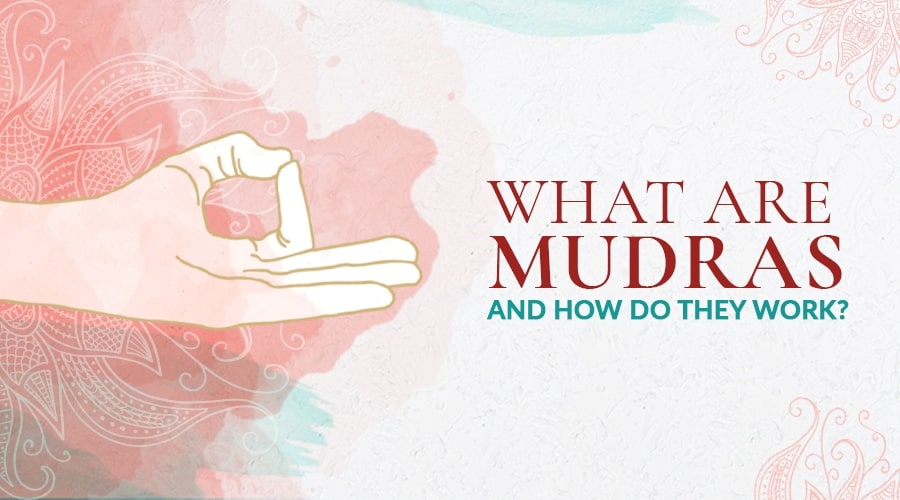You may have seen hands and fingers take an interesting shape or form during yoga practice or meditation. The likes of hands in prayer position before Surya Namaskar or connecting the thumb and index fingers of both hands in meditation? Well, these positions of the hands and fingers are sacred gestures called mudras. Like other practices in yoga, they have purpose and significance.
In this blog, we’ll explore what mudras are, their importance in yoga and meditation, as well as a few of the best mudras for chakra balancing and everyday practice.
What are Mudras in Yoga?
A mudra is a gesture or seal used in yoga. The practice of these gestures and seals channel the flow of prana life force. There are many mudras. They are categorized as hand hasta mudras, body (kaya) and consciousness (citta) mudras. We commonly use hand mudras.
Ayurveda and Mudras
Ayurveda explains the body as being made up of five elements; fire, air, space, earth and water. A healthy body has a balance of these elements. Conversely, a dominating or weakening element would cause an imbalance in the body and have a negative impact on one’s health. This would express as illness or disease.
There are five elements and five fingers. Each finger represents an according element. In yoga philosophy, it is said that through each finger, runs the prana for each element. By manipulating the pranas we can increase or decrease the prana to a specific part of the body. That is why a mudra is also referred to as a seal. We are sealing or locking the pranas for a specific purpose.
When a specific mudra is used for a specific purpose, it can help restore the balance of the five elements of the body using prana.
The fingers represent, accordingly, each element:
- The Thumb - represents the fire element
- The Index finger - represents the air element
- The Middle finger - represents the space element
- The Ring finger - represents the earth element
- The Pinky finger - represents the water element
The Five Pranas
- Apana – the force required for excretion, like sweating, urinating, etc.
- Samana – the force required for digestion and metabolism.
- Prana – the force required for the heart to pump.
- Vyana – the force required circulation and movement.
- Udana – the force required for upper body actions like talking, thinking, eye movement, etc.
Five Mudras for Meditation and Yoga
Mudras function as a unifying force to bring together and balance the body through the hands.
As we have two hands, so do we have two sides of the body; solar energy on the right side and lunar energy on the left side. The Gyana Mudra, for example, connects the right solar prana via the Pingala Nadi to the left lunar energy via the Ida Nadi. Mudras work to singularly stimulate solar or lunar energy too.
Apart from balancing energies in the body, mudras are also used in meditation and yoga practice to enhance focus and help direct our awareness inwards.
There are many mudras for meditation and yoga, each with its own unique purpose and benefit for the mind, body and spirit. Some of the most widely practiced hand mudras for meditation and yoga include Namaskar Mudra, Chin Mudra, Gyana Mudra and Vayu Mudra.
Below, we explore these yoga and meditation mudras in more detail.
Read more here "What is Meditation? Definition, Goal, Benefits and How-to"
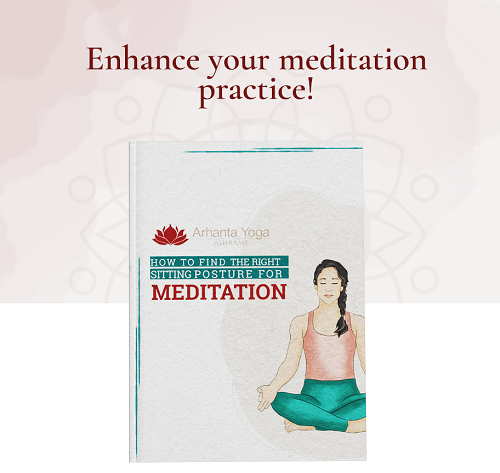
Get your free copy of the how to find the most comfortable sitting position for meditation Ebook
1. Namaskar Mudra
In this mudra we join the palms and fingers together in a prayer position in front of your heart. This mudra joins elements together and balances both sides of the body. It invokes the feeling of calmness and compassion and that is why we use it often in meditation.
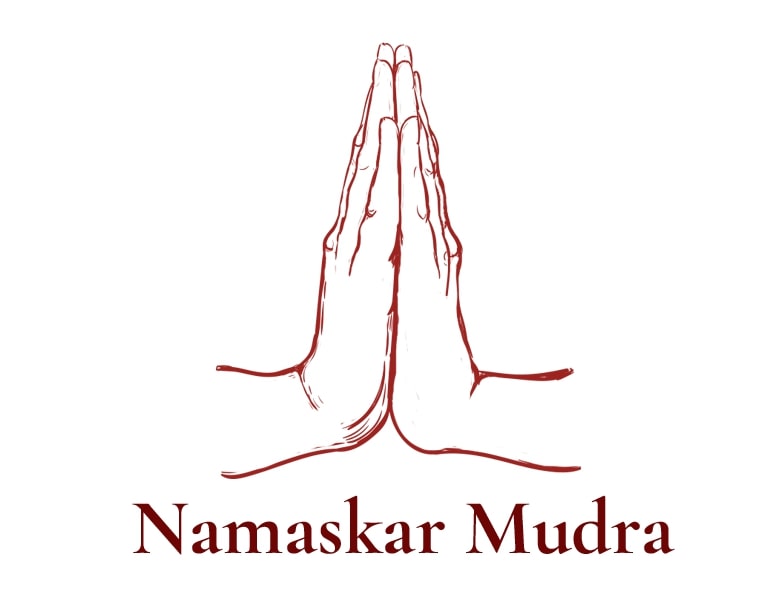
2. Chin Mudra
This is one of the most commonly practiced mudras in meditation. It is the mudra for wisdom. It involves connecting the thumb and index finger with the palms on the knees and palms facing up. Imagine holding a sheet of paper in between the fingers to get an idea of the gentle pressure to be applied between the fingers in this mudra.
In pranayama and meditation, this powerful mudra helps build concentration and heighten your internal awareness. We use this mudra during the day as the fingers and palms face toward the sun’s energy.
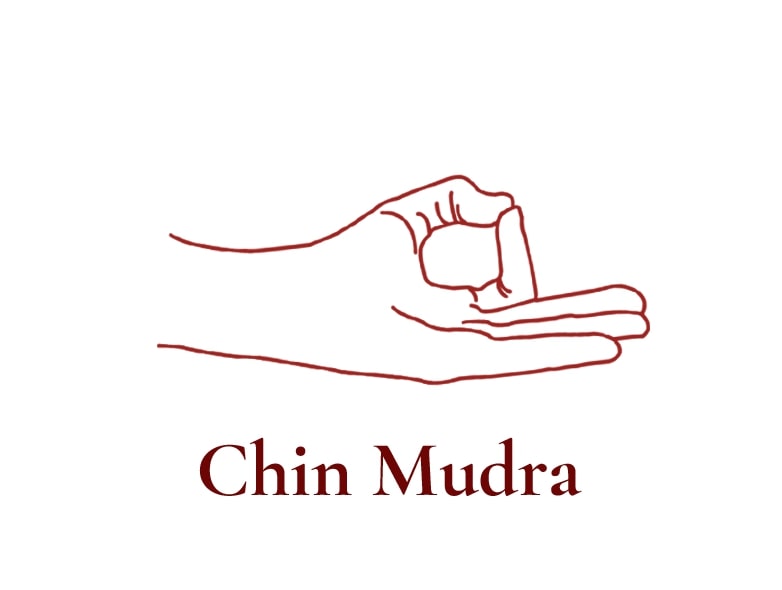
3. Gyana (Jnana Mudra)
The positioning of the fingers is like Chin Mudra but with the palms and fingers facing downward. When the sun is up, we use Chin Mudra to receive the energy of the sun. When the sun has set, we use Gyana Mudra with palms facing downward as we keep the sun’s energy we have received during the day. This mudra has the same benefits as Chin Mudra, such as helping to gain focus and internal awareness.
In this mudra we bring the thumb fire element and index air element together to burn the air and decrease vata (air) energy, helping us to concentrate better. To explain further, too much of the air element disturbs the mind. Decreasing the air element using the fire element helps to decreases mental disturbances.
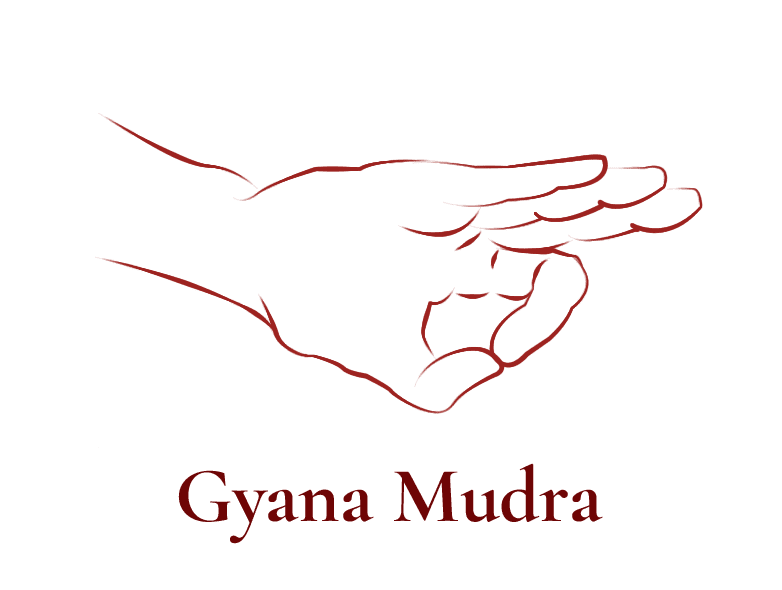
4. Vayu Mudra
This mudra is created by folding your index finger into the base of the thumb then crossing your thumb over the index finger.
This mudra is not to be confused with Chin Mudra. They are similar in their positioning of the hands and effect however, in Vayu Mudra we use it to vastly decrease the vayu air element. If the air element dominates the body, for example too much stress or anxiety issues, skin infections or much air in the intestine, you use this mudra.
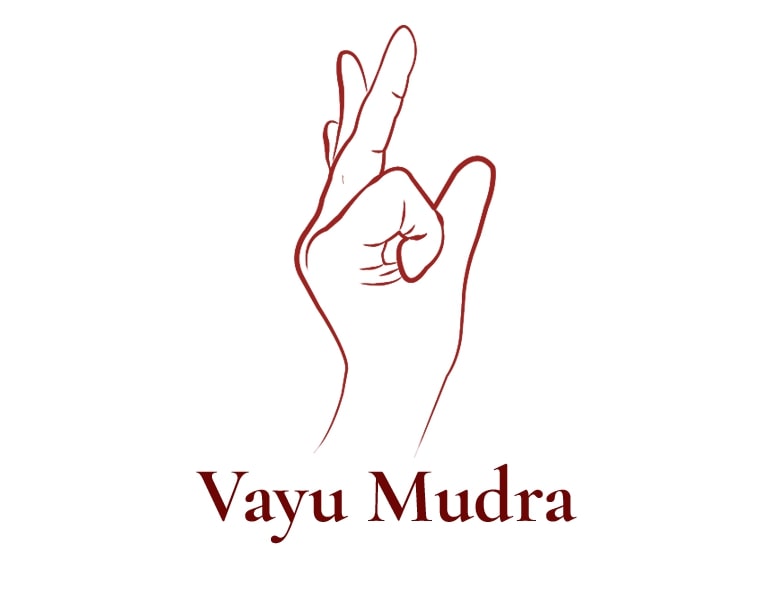
5. Dhyana Mudra
This is referred to as the ‘concentration mudra.’ For Dhyana Mudra you bring your right hand above your left hand. Rest your right hand over the left hand. Bring the tips of your thumbs together and keep the fingers together. The fire element is connected via the thumbs and the other elements are at rest.
This mudra engages the intellect and calms the mind. Dhyana Mudra is a renowned hand mudra for meditation, with many iconic pictures and statues of Lord Buddha in Dhyana Mudra.
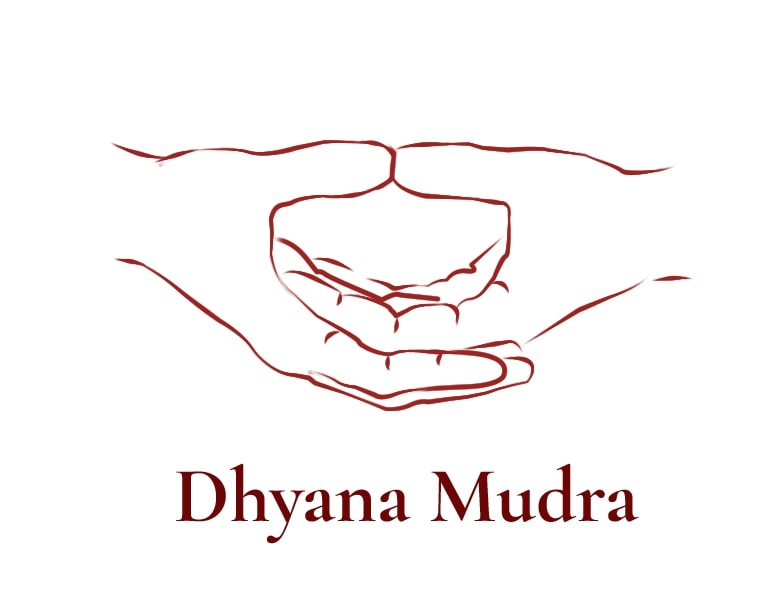

Get your free copy of the how to find the most comfortable sitting position for meditation Ebook
7 Healing Mudras for Chakra Balancing
Mudras play a powerful role in maintaining the delicate balance of the chakra system. Chakras are the energy centers of the body. There are seven chakras dotted along the spine, each responsible for specific spiritual, emotional, psychological, and physical aspects of our being.
As a result, a blockage or malfunction in the chakra system can lead to physical, psychological, and emotional abnormalities. By manipulating energy in the body, chakra mudras can help you restore balance to your energy system and cultivate a healthier wellbeing.
As mentioned above, each of the fingers represents an element. This is the same for the first 5 chakras in the body:
- Root Chakra (Muladhara) - Earth Element
- Sacral Chakra (Svadhishthana) - Water Element
- Solar Plexus Chakra (Manipura) - Fire Element
- Heart Chakra (Anahata) - Air Element
- Throat Chakra (Vishuddha) - Ether (Space) Element
- Third Eye Chakra (Ajna) - Light
- Crown Chakra (Sahasrara) - Thought
To balance the chakras, we balance the element in the body by performing the corresponding mudra. Here are 7 mudras for chakra healing, activation and alignment:
1. Prithvi Mudra for the Root Chakra (Muladhara Chakra)
Meaning ‘earth’ in Sanskrit, Prithvi is a mudra typically performed in yoga and chakra meditation to awaken the earth element and restore balance to the Root Chakra. This grounding Root Chakra Mudra promotes stability and inner strength. Prithvi Mudra is also used in Ayurveda to purge toxins from the body and treat digestive disorders.
This Root Chakra Mudra is fairly simple to form and only requires the tips of the fingers to touch. With your hands pointed up to the sky, allow the tips of your ring finger and thumb to meet in the middle of your palm.
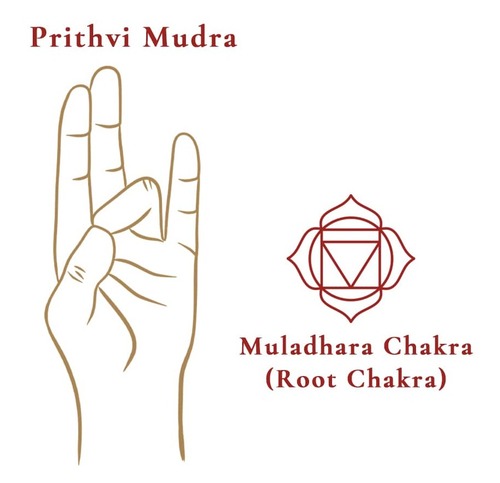
2. Varun Mudra for the Sacral Chakra (Svadhishthana Chakra)
The Varun Mudra is a popular hand gesture in meditation and pranayama that increases the water content in your body and restores balance to the Sacral Chakra. If your body does not have enough water, it cannot function properly. The Varun Mudra corrects this imbalance, hydrating the body and purifying the blood for healthier skin and strong joints. As a mudra for the Sacral Chakra, it also reduces symptoms caused by a blocked Sacral Chakra.
To perform this Sacral Chakra Mudra, open your palms and clear your mind. Then, join the tip of your little finger with the tip of your thumb. The remaining fingers will naturally curl in, but try your best to keep them straight without straining your hand.
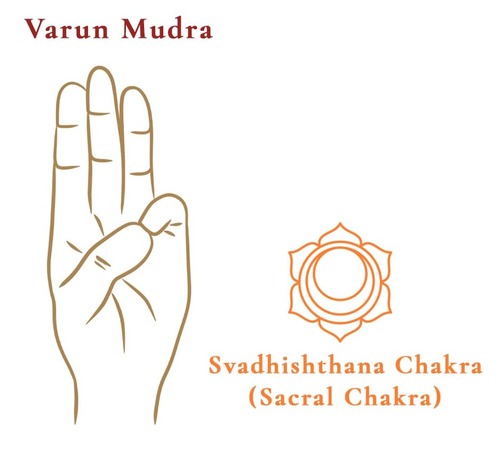
3. Agni Mudra for the Solar Plexus Chakra (Manipura Chakra)
The Agni Mudra is associated with the fire element which manifests itself as heat in the body. Performing this Solar Plexus Mudra in meditation or yoga stimulates your ‘agni’ or digestive fire, which aids digestion and ignites our inner light. With your conscious mind wide awake, you’ll gain clarity on your life and boost your self-esteem.
To activate your Manipura or Solar Plexus Chakra with the Agni Mudra, fold your ring finger into your palm and gently rest the base of your thumb over the top of your ring finger.
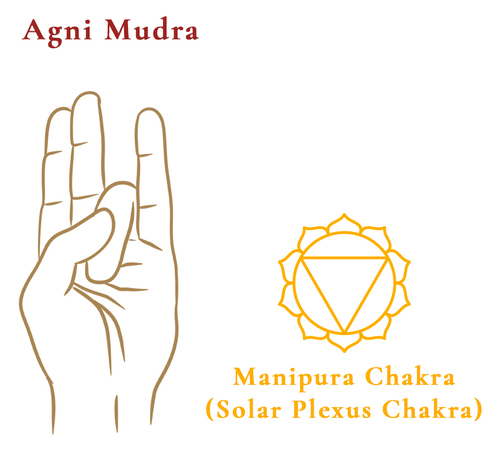
4. Vayu Mudra for the Heart Chakra (Anahata Chakra)
Translating to ‘wind’ or ‘air,’ the Vayu Mudra is a powerful hand gesture that balances the air element in the body and realigns the Heart Chakra. Performing the Vayu Mudra can bolster your sense of Self and eliminate restlessness and indecisiveness. On a physical level, this powerful Heart Chakra Mudra can also remove excess air blocked in the body and ease symptoms of diseases like Sciatica and Parkinson’s, as well as knee pain.
To practice this Heart Chakra Mudra, cross your thumb over the tip of your index finger. Allow your thumb to rest here gently, ensuring that all your other fingers are extended.
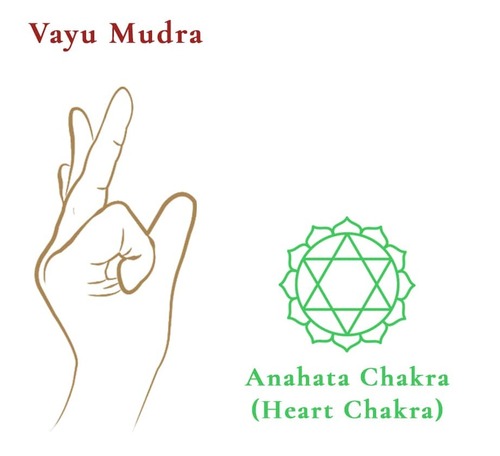
5. Akash Mudra for the Throat Chakra (Vishuddha Chakra)
The Akash Mudra, also known as Shuni Mudra, is a popular hand gesture typically used in Ayurveda to increase space in the chakra system and activate the Throat Chakra. Regular practice of this Throat Chakra Mudra can increase calcium content and manage certain health problems such as a locked jaw and high blood pressure. Mudras for the Throat Chakra can also boost your intuition and expand your consciousness.
To form the Akash Mudra, simply join the tip of your middle finger with the tip of your thumb and straighten the rest of your fingers.
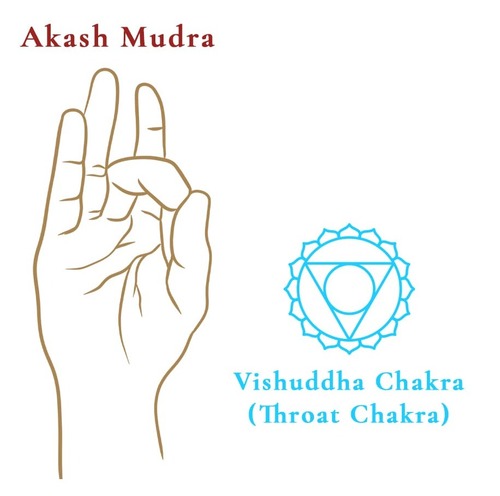
6. Hakini Mudra for the Third Eye Chakra (Ajna Chakra)
The Hakini Mudra is a sacred hand gesture associated with the divine energy. Also called the mudra of the mind, practitioners use this mudra to channel prana to the Third Eye or Ajna Chakra and open one’s conscious mind. If you struggle to focus or find yourself overthinking everything, this Third Eye Mudra can improve your concentration and enhance your creativity.
To practice the Hakini Mudra, draw your fingertips and thumbs together to touch lightly in the center of your body. Imagine there is a ball of light between your hands. You can hold the pose here or raise the mudra up to the Third Eye Chakra, in the center of your forehead.
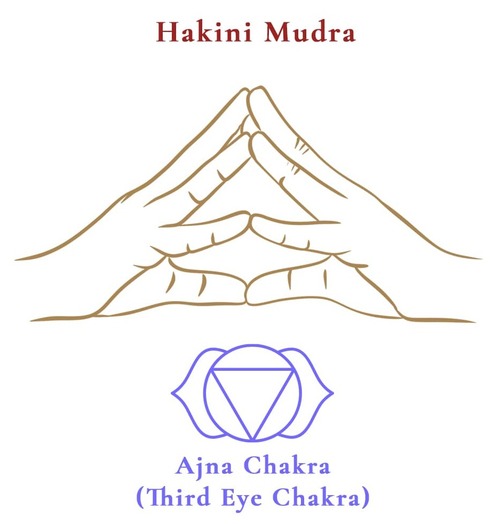
7. Dhyana Mudra for the Crown Chakra (Sahasrara Chakra)
As mentioned above, the Dhyana Mudra is a concentration mudra which helps practitioners reach a deeper state of meditation. It is also used to awaken the Crown Chakra and promote inner peace.
To form this Crown Chakra Mudra, rest your right hand on top of the left, palms facing upward. Then, raise your thumbs slightly so that the tips meet in the middle.
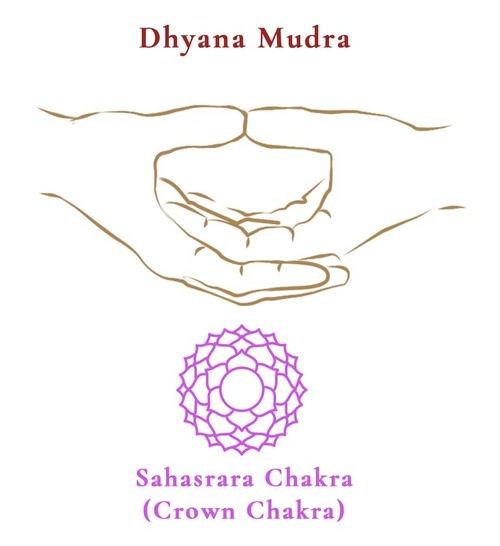
Final Thought
Mudras are powerful tools that can deepen your focus, balance your energies within and improve your overall health and wellbeing. Incorporating these hand gestures into your daily yoga and meditation sessions will also add a new dimension to your practice.

Get your free copy of the how to find the most comfortable sitting position for meditation Ebook

